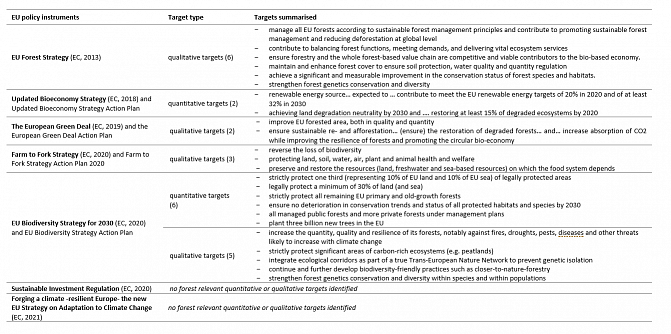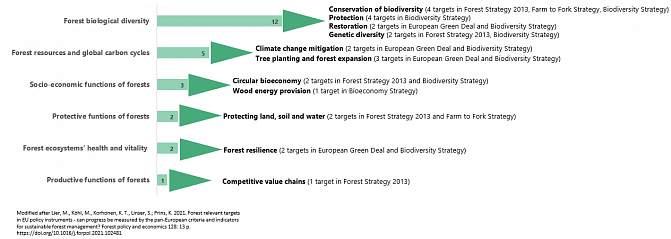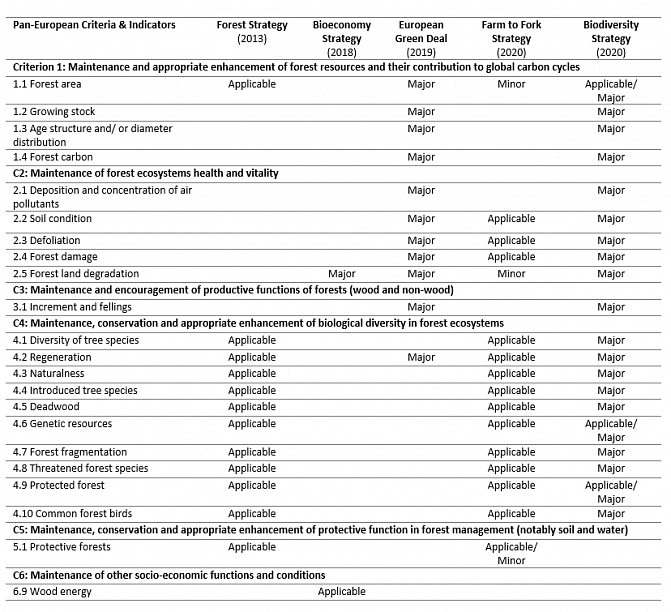Forest relevant targets in EU policy instruments – what are they and can their progress be measured using the pan-European Criteria and Indicator for Sustainable Forest Management (SFM)?
Are there EU policy instruments with specific targets that are relevant to forest policy and management? What are these targets, and can progress of the targets be measured using the pan-European Criteria and Indicator for Sustainable Forest Management? And what could this mean for forest relevant target setting in the future?
Forest relevant targets in EU policy instruments
Under the umbrella of European Green Deal (2019) there are a number of existing and upcoming EU policy instruments with specific targets that are relevant to forest policy and management. A recent study looked at seven EU policy instruments that are relevant to forests (Table 1). These instruments differed in their nature, as some are legally binding regulations, while others are broad strategies, and some are more action oriented.
The studied showed that most of these policy documents and instruments are closely interlinked with each other with many cross-references. This is true in particular, for the Bioeconomy Strategy, the Farm to Fork Strategy, the Biodiversity Strategy and the Adaptation to Climate Change Strategy, as they have been developed and approved more or less simultaneously and coordinated through the European Green Deal, which refers to them all, as well as to the forthcoming revised EU Forest Strategy.
What are forest relevant targets in the current EU forest related policy instruments?
In the studied EU forest related policy instruments, eight quantitative and 16 qualitative targets were identified which explicitly address forest relevant issues. Quantitative targets were targets which focus on outcomes or results which are measurable, for instance:
“achieving land degradation neutrality by 2030 and to the ambition of restoring at least 15% of degraded ecosystems by 2020”, and qualitative targets are targets which are not quantifiable or have not been set in a quantified way, for instance: “EU’s forested area needs to improve, both in quality and quantity, for the EU to reach climate neutrality and a healthy environment” (Table 1).
Most of the identified forest relevant targets (12 in total) focus on biodiversity, in particular on the conservation of biodiversity, on forest protection, on forest restoration, and on genetic diversity. Fewer targets focus on forest area and carbon flows, socio-economic functions, and protective functions of forests, forest health and vitality, and productive functions of forests (Picture 1). This can be explained due to the different nature of the documents, some of which are highly specific, and some are more general.
The study showed that forest issues are not approached at the policy level in a sector-defined “silo”. Forest relevant targets are completely integrated into EU policy instruments, appearing alongside targets for neighbouring sectors or actions in a wider context. Even the Forest Strategy 2013 focuses on coordinating the links with other sectors, and not on developing the “forest sector” in splendid isolation. Indeed, some of the main features of the new Forest Strategy which is at present still under development, have already been laid down in the Biodiversity Strategy, ensuring that biodiversity objectives do receive the necessary attention in the forest strategy.
Can progress of the identified forest relevant targets be measured by the pan-European six criteria and 45 indicators for sustainable forest management?
The forest sector, accustomed to integrating the complexity and long time scale of forest ecosystems into its work, has developed tools for monitoring all aspects of sustainable forest management, notably the pan-European Criteria and Indicators for SFM and the data collection and analysis systems which accompany them. Could the pan-European Criteria and Indicators also be used for measuring the progress of forest relevant targets in policy instruments?
The study showed that of the 34 pan-European quantitative indicators, 22 are potentially suitable to provide information on the progress towards the identified EU forest relevant targets (Table 2). 20 and 16 indicators, respectively, are appropriate for reviewing the targets of the Biodiversity Strategy and the Farm to Fork Strategy. Fewer indicators are appropriate for providing information on progress towards targets in the context of the European Green Deal and the Forest Strategy. The suitability of the pan-European indicators for providing information on progress towards targets varies across strategies, and some of the indicators would need to be adjusted in order to verify the targets stated in the strategies.
And what could this mean for forest relevant target setting in the future?
In formulating policy objectives qualitative targets predominate, and quantitative targets are more the exception than the rule. The quantitative formulation of a target usually requires a much higher negotiation effort than a qualitative target, especially when certain central aspects (e.g. in this case, forest policy) are the responsibility of EU member states. In order to achieve or support the quantitative or qualitative targets, appropriate policy tools (e.g. regulations) have to be set in place. It will be interesting to see on how forest relevant targets of the already existing forest related EU policy instruments will be integrated into the new EU Forest Strategy.
When considering the use of the pan-European indicators to provide information on progress towards EU forest relevant targets, it is worth recalling that they have different objectives and emerge from different processes. The main differences are geographical scope (EU v. pan-Europe), institutional framework (supranational, complex EU institutions v. non-legally binding Forest Europe) and the holistic approach of the indicator set, whereas the targets are more focused on specific policy issues.
Nevertheless, there is a clear overlap of issues and geographical scope between the pan-European indicator set and the forest related EU policy instruments. There is a clear potential to use the data collected in the framework of the pan-European criteria and indicators to provide information on progress towards some of the EU forest relevant targets – provided the targets, when necessary and possible, use the same language (terminology, definitions etc.) as the indicators. If the EU were to use the terms used in the indicator set to formulate its targets, monitoring would be much easier, and the monitoring would be put in a broad context of SFM.
Last but not least, an example on how the pan-European indicators for SFM are currently used when monitoring the transition towards a circular and climate-neural bioeconomy at EU level
A EC JRC report states
” because of its inherent complexity and the very high level of ambition of the Bioeconomy strategy itself… the progress towards a truly sustainable”(circular)
“bioeconomy must be closely monitored with reliable data and robust analysis to provide a holistic view of all the dimensions of sustainability and to highlight eventual trade-offs among them. Further, monitoring is essential to identify areas in need of policy intervention as well as to assess the coherence and the impacts of existing legislation.”A first step to provide this holistic view was for the EC JRC to set a monitoring framework to measure the progress towards the five objectives of the EU Bioeconomy Strategy 2018, and their contribution towards a circular and climate-neural economy. The EC JRC monitoring framework includes for each of the five objective a list of basic indicators, of which several are forest related, and in the wider sense based on the pan-European indicators for SFM (e.g. share of forest area, increment and fellings, deadwood, threatened forest species, common forest birds, or employment in the forest sector). This is a good example of cross-sectoral application of the pan-European indicator for SFM.
This main text is based on the publication:
Lier, M., Köhl, M., Korhonen, K. T., Linser, S.; Prins, K. 2021. Forest relevant targets in EU policy instruments - can progress be measured by the pan-European criteria and indicators for sustainable forest management? Forest policy and economics 128: 13 p.
https://doi.org/10.1016/j.forpol.2021.102481Reference to the JRC report:
La Notte, A. et al. 2020. Building a monitoring system for the EU bioeconomy. Progress report 2019: description of framework. Joint Research Centre (European Commission).
https://op.europa.eu/en/publication-detail/-/publication/9be6bf37-3e5e-11ea-ba6e-01aa75ed71a1






